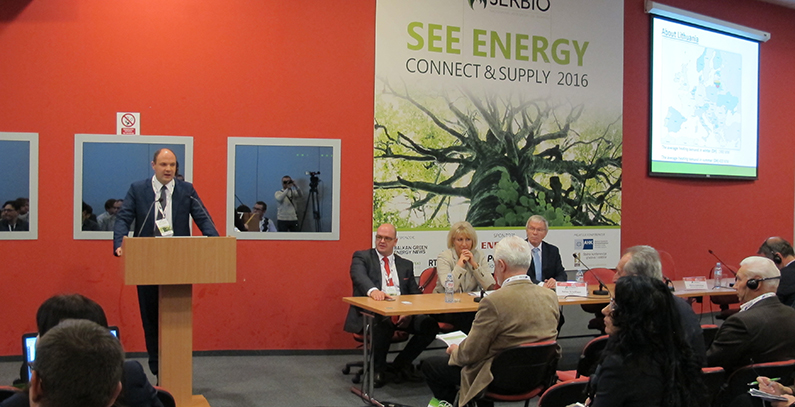
Slika: Serbio
The utilization of renewable energy sources in Serbia has been on the rise in recent years, but huge biomass potential to generate heat and electrical energy is still far from being fully exploited. This is the main message sent from the international conference “SEE Energy – Connect & Supply 2016” held in Novi Sad and organised by the Serbian National Association for Biomass Serbio.
Promising assistance to potential investors, Igor Mirović, the Prime Minister of the Autonomous Province of Vojvodina, said that the decision-makers still have to learn more about biomass and its potential. He reminded that merely 3-5% of the energy consumed in Vojvodina is produced from biomass, which is unfortunately still perceived as “another by-product of the agricultural production”.
The conference heard the words of support from the president of the German-Serbian Chamber of Commerce Martin Knapp, who stressed the importance of using the scientific achievements, as well as connecting domestic and foreign renewable energy companies.
As the host of the event, Nataša Pavićević Bajić, the president of Serbio praised the number of attendees and provided an insight into the way circular economy is actually created. “With every dinar we pay for natural gas, our country is getting poorer. With every dinar we pay for heating generated from our own resources, it pays off to us,” explained Nataša Pavićević Bajić, outlining the huge biomass potential. “All the analysis say that two thirds of our overall renewable energy sources are biomass resources, that is agricultural and forest biomass.”
Rainer Schellhaas, GIZ DKTI’s Biomass Supply Component leader, expressed satisfaction with fact that there is a surging interest of the towns and municipalities across Serbia to start using biomass in district heating systems. He took an example from the municipality of Priboj, in southwestern Serbia, which started using biomass for heating of its public buildings. Schellhaas also reminded about potentials of the biomass-fuelled cogeneration facilities (CHP) and hoped to see more of them in Serbia in the future.
Biomass projects need financing in order to become materialized. The conference participants noticed that commercial banks in Serbia seem to be puzzled about formulating credit lines for the biomass projects, thus making its financing more difficult.
Success stories from Serbia and abroad
A success story arrived from Lithuania, where biomass potentials have been massively utilized. The conference heard Marius Dubininkas, commercial director and board member of the Enerstena Group, the leader of biomass heating technologies in Baltic countries. Around 33.2% of the Baltic country is covered with forests, whereas the biggest amount of energy generated from renewable energy sources originates from biomass. In the city of Kaunas, where Enerstena headquarters is located, the price of heating plunged 50% after the community started using biomass for heating. Enerstena, biomass heating technology producer, provided district heating for around 300,000 citizens of this town. Since the system is designed as a CHP, it produces electrical energy thus generating additional income.
With plenty of biomass in the country, Lithuanian entrepreneurs opened 6,500 jobs in recent years, and another 1,000 are expected to be created by 2020. By then, biomass would make up to 80% of the total renewable energy sources in the country.
The unused biomass potential amounts to throwing gold around, according to Viktor Radić, regional manager of Austrian company Polytechnik GmbH . He listed often forgotten by-products: branches, leaves, hay, pressed fruit mass, vineyard waste, coffee beans peel, animal excrement and another 140 types of by-products. None of it is waste, but merely unused biomass, reminded Radić. He presented his company’s portfolio, including cooperation with numerous small and medium size companies but also renown clients like Airbus and L’Oréal. Radić also added that this family owned and managed company with fifty-year long tradition has been offering biomass technology solutions from silos to boilers. “One of the competitive advantages of biomass lies in its rather short pay-back period, since its does not require additional treatment”, concluded Polytechnik’s representative.
Diversified portfolio of energy services and equipment characterizes Serbian company EnergyNet from Kać, which has performed a string of heating and cooling projects in the last 20 years. Nebojša Mišić, Business Development Manager in this company outlined the company’s contribution to raising awareness and education of proper equipment handling and knowledge sharing for professionals and equipment users, which represents a program of company’s educational Academy. It is also evident that biomass projects executed by EnergyNet generate more and more attention in the market.
There is a village in Serbia that satisfies majority of its energy needs from biomass. The Village of Kostejevići in Bajina Bašta municipality, became the first Biovillage in the BioVill project, that is being implemented by the Standing Conference of Towns and Municipalities (SKGO).
Producing biomass and creating biomass market
In order to fully utilize biomass potential, it is necessary to establish a proper biomass market which is yet to be created in Serbia, according to Vojislav Milijić from Serbio. He is the leader of the BioRES Project in Serbia which aims to create biomass logistics and market centres (BLTCs). The centres would act as mediators between local suppliers and buyers – heating plants, electricity plants, and households. With an important support from the European Union’s Horizon 2020 project worth EUR 1.86 million, BioRES is triyng to establish 6-8 regional centres in Bulgaria, Croatia and Serbia. The centres should secure contracts for delivery of at least 8,000 tons of wood biomass, which equals around 1,000 tons per centre. One of the BioRES goals is an outreach to private forest owners, since they hold 50% of the woods, and hence a half of available wooden biomass in Serbia.

















Be the first one to comment on this article.